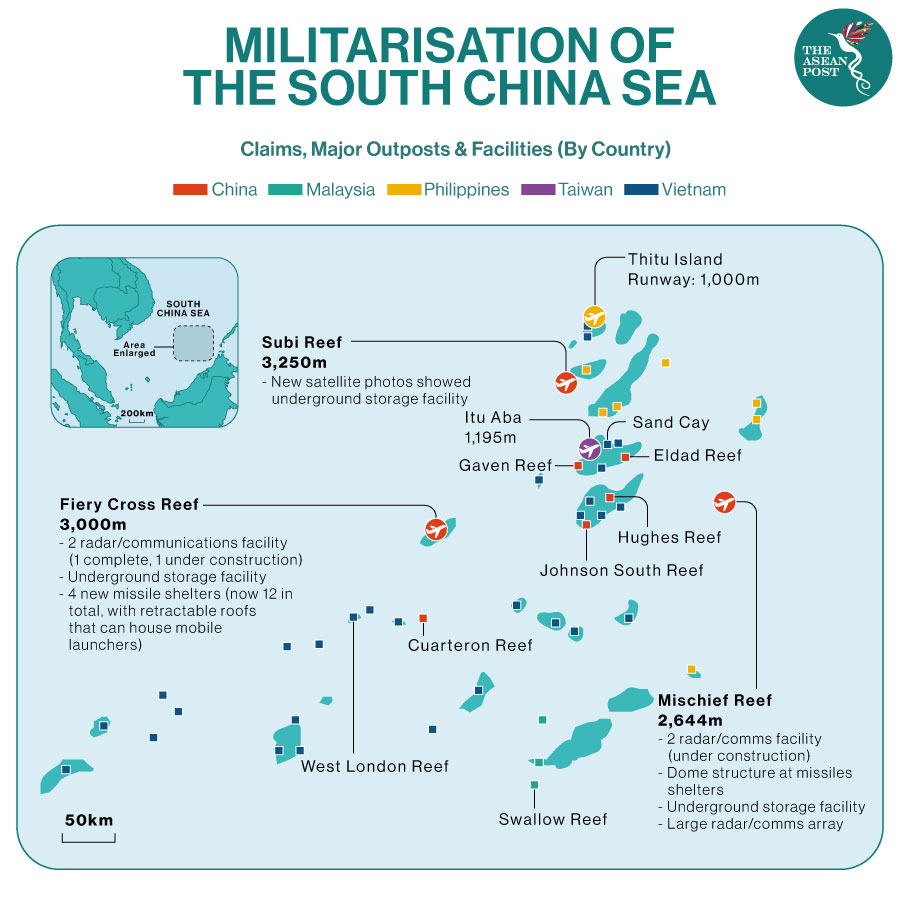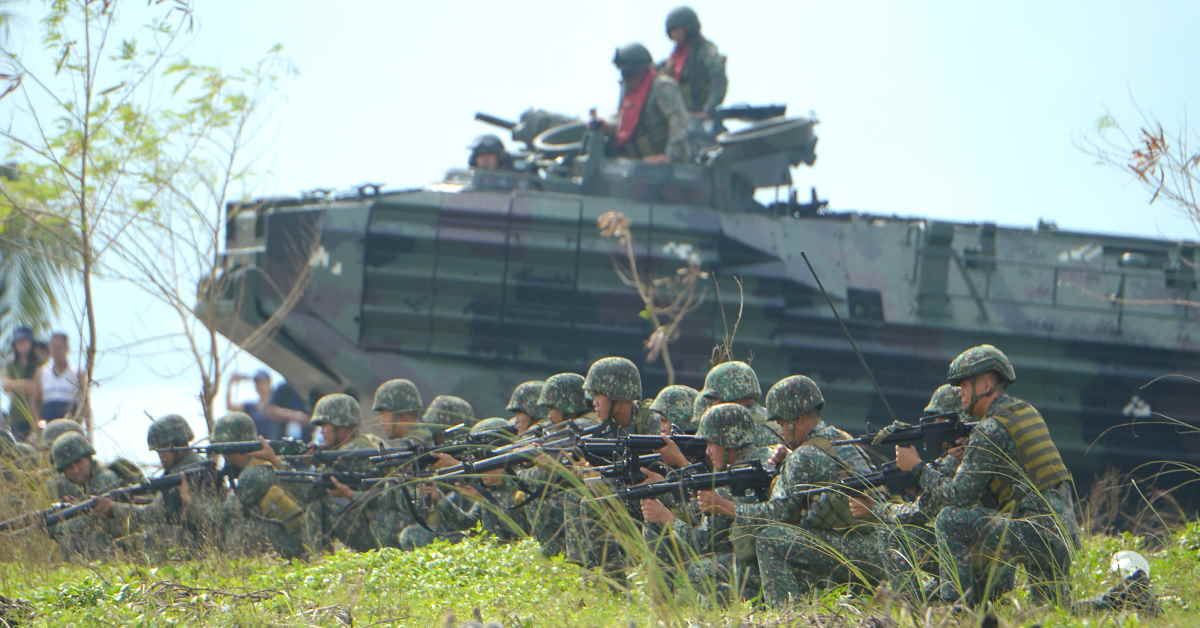In the post-Cold War era, the formation and the creation of regional groups like ASEAN and the European Union (EU) bears the promise of promoting not only regional bargaining economic power but as alternative mechanisms and structures in facilitating and consolidating regional peace, security, and stability within the territorial boundaries of these regional groupings and beyond.
Regional blocs like ASEAN were established in an attempt to facilitate and promote regional collective peace, security, and stability through idealised norms and practices of meaningful and peaceful cooperation among their member states.
Gunboat Diplomacy
Nevertheless, given the lingering cold war atmosphere between China and the United States (US) and the continuous drills in the exercise of the “gunboat diplomacy” in the disputed waters of the South China Sea (SCS) by the US and its strategic security allies like France, Great Britain, Australia, and even Japan to deliberately challenge to the point of provoking China several times over.
This somewhat begs the question if ASEAN is indeed a “regional security architecture” (RSA) that is credible and capable of promoting regional peace, security, and stability that can withstand the on-going power struggle, rivalry and the contest for supremacy of the two superpowers in the SCS.
To note, gunboat diplomacy refers to the conspicuous displays of naval power to threaten other countries to achieve foreign policy objectives and force the threatened countries to make concessions in territorial or trade issues.
It can be recalled that recently, a French nuclear attack submarine “Émeraude” and naval support ship “Seine” carried out a patrol through the SCS as part of French efforts to challenge China’s “sweeping claims” over the disputed waters of the SCS.
Also, around the third week of January 2021, the US sent the Theodore Roosevelt aircraft carrier into the highly contested waters of the SCS. The US, France, Great Britain, Australia, and even Japan have carried out several freedom of navigation operations with their military/nuclear ships and submarines sailing through the contested waters of the SCS in the recent past in an attempt to push back China’s growing regional power, presence, and influence in the SCS.
Subsequently, China responded by conducting naval military drills in the SCS. Just recently, China’s People’s Liberation Army (PLA) held military exercises in the waters to the west of the Leizhou Peninsula in the South China Sea for four days. This is the first military drill by the PLA since the new US administration was inaugurated under Joe Biden.
Likewise, China has long protested against the presence of foreign warships in the South China Sea and has expressed time and again that it is serious and is strengthening its resolve to protect its territorial jurisdiction and sovereignty if challenged by external forces.
Hence, it seems that the “gunboat diplomacy” being displayed by both sides of the fence not only further complicates the SCS dispute, rather it is also heightening the “security dilemma” in the contested waters, intensifying the prospects of a military confrontation between China and the US and its allies. If this happens, ASEAN and its member states could be the primary victims.
As a matter of proviso, one must not neglect the possibility of the fact that the two superpowers may fall into the so-called “Thucydides Trap,” where the “tug of war” between a declining power and a rising power could lead to an actual war if the military exercises in the SCS are not managed well by both parties.
This further complicates an already complex and tension-driven security situation in the SCS if competing parties involved in the maritime dispute including ASEAN are not able to manage the peaceful resolution of this maritime dispute involving China, the US and its allies.
ZOPFAN
ASEAN member states should at least come up with a common understanding of how they should deal with China and the US vis-à-vis the geopolitical complexities and realities around the SCS. This challenging and daunting task can be guided and facilitated through the operationalisation of the principles enshrined in the ZOPFAN (Zone of Peace, Freedom, and Neutrality).
ZOPFAN is a declaration signed by Foreign Ministers of the original five member-states of ASEAN namely Indonesia, Malaysia, the Philippines, Singapore, and Thailand on 27 November, 1971 in Kuala Lumpur. 49 years ago, these ASEAN member states declared their intent to keep Southeast Asia free from any form or manner of interference from “outside powers,”; practicing peaceful co-existence, preserving the independence and sovereignty of individual states, and broadening areas of cooperation.
COC In The SCS
The Code of Conduct (COC) in the SCS without the intervention of the US and other countries not party to the dispute is yet another mechanism that offers a set of norms of behaviour that may regulate the interaction of states that are party to the dispute.
The COC will play a very important role in resolving the SCS dispute, and in reducing the potential for conflict. ASEAN and China signed a declaration on conduct for the South China Sea in November 2002, which was the first time that China had accepted a multilateral agreement on the issue. China is pushing for the COC with ASEAN and wants negotiations completed as soon as possible.
Likewise, the COC is important as it provides a framework of rules, principles, norms, and decision-making procedures for the management and resolution of disputes among claimant countries over the SCS. An ASEAN-China COC on the SCS will create new forms of commonality and cooperation among the parties through dialogues and negotiations. It is a viable diplomatic mechanism as it can provide international rules-based order for the SCS.
However, for the ASEAN-China COC to be effective, it must be supplemented by the institutionalisation of additional multilateral and bilateral negotiations among claimant countries on matters related to fishery management, environmental cooperation, and oil and gas development among others, which are important economic issues that might trigger potential conflicts if not addressed adequately.
MDT And The VFA
Nevertheless, Foreign Affairs Secretary Teodoro Locsin Jr. on Monday (8 February, 2021) stated that the Philippines has opposed efforts to block foreign powers, particularly the US from having access to the SCS under the Code of Conduct being drummed-up by ASEAN member states and China.
"Here is the non-negotiable, the COC will never exclude a Western power, well the United States, from the area because that's part of our national defense, it's the MDT (Mutual Defense Treaty), and that America’s continuing presence will ensure “balance of power” in the region,” he said in a media interview.
This is testament that ASEAN governments see security and stability through the lens of the nation-state.
To note, the MDT is a 70-year-old defense accord that binds America to defend its Asian ally from aggression. The MDT between the Philippines and the US was signed on 30 August, 1951, in Washington, D.C. and was established to provide mutual support in case of a foreign attack.
Nevertheless, the MDT is actually “hanging in the balance” at the moment. It was no less than President Rodrigo Duterte who expressed some kind of ambivalence to the MDT and raised some foreboding thoughts if in any case the US is indeed is a reliable security partner.
Duterte made a bit of elucidation in this regard in his speech during the inspection of air assets at Clark Air Base in Pampanga on 12 February, 2021, striking a chord by reminding the Americans that the military pact allowing joint Philippine-U.S. military operations is a “shared responsibility.”
The commander in chief and the sole architect of the country’s foreign policy also expressed that the US government failed to deliver some of its previous promises to the Philippines.
“In the past, we ordered so much from them and so much were not delivered at all. What I don’t like is para kang bata na (you’re like a child), they promise you, magpunta ang top brass nila (the top brass will visit), this group promises you and once they take-off they forget about it,” Duterte said.
The Visiting Forces Agreement (VFA) is an agreement between the Philippines and the US in support of the MDT.

Balance Of Power
On the issue of balance of power, one has to take note of America’s policy of containing China by keeping around a hundred thousand troops in East Asia and providing security guarantees to Japan and South Korea. This is intended to prevent a new balance of power from forming in Asia or in the Indo-Pacific region, that may require the military presence of the US and its allies’ in the region.
The US is containing contending powers like China from rising to keep the world a unipolar one; to maintain its hegemonic position and the status quo in Asia and the Indo-Pacific so as not to alter the power equation in the region.
In the balance of power discourse surrounding the SCS, it’s not an individual member state alone that is dealing with China but rather ASEAN as a regional bloc. ASEAN is a contending force to reckon with that can offer a counterweight if it gets its act together, and stands solid and united as the SCS dispute could be resolved peacefully and amicably through dialogue and cooperation within the ambit of ASEAN structures, processes, and mechanisms.
Conclusion
In retrospect, what the SCS needs at the moment is a cooling-off period in which western powers step back from exercising “gunboat diplomacy” intended to challenge and provoke China. Instead, they should leave ASEAN, China, and the rest of the claimant states to hammer out the conclusion of the COC by exploring all possible mechanisms to manage and resolve disputes surrounding the waters of the SCS peacefully guided by relevant international laws.
Hence, the US and other countries which are not party to the conflict should refrain from intervening so as not to muddle and complicate the issues surrounding the SCS further. Whereas, China must take greater responsibility and behave constructively and responsibly as a stakeholder in the SCS with other claimant countries.
If ASEAN wants the region to be a cohesive “zone of peace” or a “security community”, it must transcend and uphold the intent and purpose of the ZOPFAN and the COC. If not, it will be like “a tree without roots, and water without a source.”
Related Articles:

